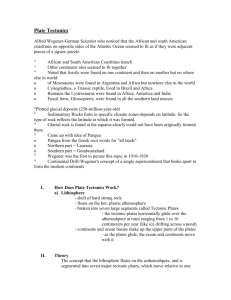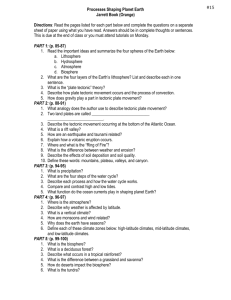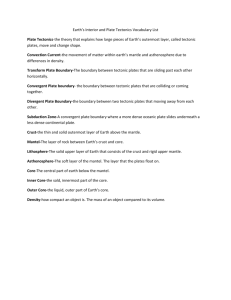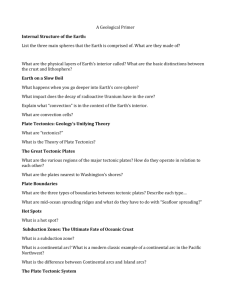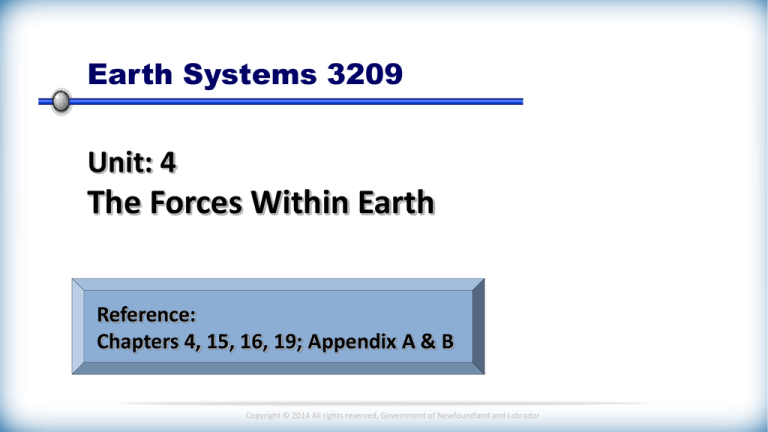
Earth Systems 3209
Unit: 4
The Forces Within Earth
Reference:
Chapters 4, 15, 16, 19; Appendix A & B
Copyright © 2014 All rights reserved, Government of Newfoundland and Labrador
Unit 4:
Topic 2.3
Plate Tectonic Theory
Focus on . . .
describing the theory of plate tectonics.
Copyright © 2014 All rights reserved, Government of Newfoundland and Labrador
Plate Tectonic Theory
The theory of plate tectonics is one of the great
advances in the twentieth century.
In the 1960's, scientist such as Alfred Wegener
proposed the “continental drift theory”, and Tuzo
Wilson put forth the idea that, “Earth consisted
of several different fragments called plates,
instead of being made up of one static, rigid,
Text Reference:
solid layer.”
Pages 525-527
This revolutionized the way scientist think of
Earth today.
Copyright © 2014 All rights reserved, Government of Newfoundland and Labrador
Plate Tectonic Theory
A Tectonic Plate is a massive, irregularly shaped slab of solid
rock, generally composed of both continental and oceanic
lithosphere.
Plate size varies from a few hundred to thousands of kilometers
across, with the Pacific and Antarctic being the largest.
These massive slabs seem to float because of their
composition.
-- Continental crust is composed of Granitic rocks, which are
made of felsic minerals and are less dense. (up to 100km thick)
-- Oceanic crust is composed of Basaltic rocks, which are made
of mafic minerals and are more dense. (5 – 7 km thick)
Copyright © 2014 All rights reserved, Government of Newfoundland and Labrador
Plate Tectonic Theory
By the end of the 1960’s the ideas of continental
drift and seafloor spreading were united and gave
rise to a new theory that better explained the idea
of a mobile Earth. This theory was called the
Plate Tectonic Theory.
The birth of the plate tectonic theory helped
explain various geologic phenomena. Scientist
believe that the grinding movements of Earth’s
lithospheric plates generate earthquakes, create
volcanoes, and deform large masses of rock into
mountains.
Copyright © 2014 All rights reserved, Government of Newfoundland and Labrador
Plate Tectonic Theory
A Canadian geologist named Tuzo Wilson was the person who
proposed the Plate Tectonic Theory.
The Theory of Plate Tectonics States:
“Earth’s lithosphere is divided into seven (7) main tectonic
plates, namely;
1) North American
2) South American
3) Pacific
4) African
5) Eurasian
6) Australian
7) Antarctic
These tectonic plates are in continuous slow motion relative
to each other . Motion occurs along one of three types of
boundaries bordering each plate.”
Copyright © 2014 All rights reserved, Government of Newfoundland and Labrador
Plate Tectonic Theory
Three Types of Plate Boundaries Include:
1) Divergent Boundary
Plates move apart, resulting in upwelling of molten
material from the mantle to create new ocean floor.
Features on the ocean floor called Ridges, show this
form of plate movement.
Tensional forces cause the plates to move apart.
Ocean
Moho
Ocean Crust
Magma
Continental Crust
Copyright © 2014 All rights reserved, Government of Newfoundland and Labrador
Plate Tectonic Theory
Three Types of Plate Boundaries Include:
2) Convergent Boundary
Plates move together, causing one slab of
lithosphere to be consumed into the mantle as it
descends beneath the overriding plate.
Features called ocean trenches are formed at
these boundaries. Lithosphere is
destroyed at these boundaries.
Compressional forces cause the
plates to move together.
Copyright © 2014 All rights reserved, Government of Newfoundland and Labrador
Plate Tectonic Theory
Three Types of Plate Boundaries Include:
3) Transform Boundary
Plates move past each other in opposite directions.
Lithosphere is not created or destroyed at these boundaries.
No vertical movement. For example, San Andreas Fault.
Shearing forces cause the plates to move past one another.
Birds Eye View or
Top View
Copyright © 2014 All rights reserved, Government of Newfoundland and Labrador
Plate Tectonic Theory - Evidence:
1) Earthquakes and Volcanoes
2) Polar Wandering
3) Magnetic Reversals and Seafloor Spreading
4) Ocean Drilling and Heat Flow
5) Hot Spots
Copyright © 2014 All rights reserved, Government of Newfoundland and Labrador
Example 1:
Which Canadian scientist is recognized for his contribution
to the Plate Tectonic Theory?
(A) Harry Hess
(B) Dan McKenzie
(C) Drummond Matthews
(D) Tuzo Wilson
What is the major driving force of plate tectonics?
(A) continental drift
(B) rifting of the plates
(C) plate subduction
(D) upper mantle convection
Copyright © 2014 All rights reserved, Government of Newfoundland and Labrador
Example 2:
What happens at a transform plate boundary?
(A) major mountain belts are produced by continental collision.
(B) new oceanic crust is produced.
(C) plates are subducted into the mantle.
(D) plates move past each other along a fault.
Which plate boundary is demonstrated in
the diagram to the right?
(A) compression
(B) convergent
(C) divergent
(D) transform
Copyright © 2014 All rights reserved, Government of Newfoundland and Labrador
Your Turn . . .
Take the time and complete the following questions . . .
(Solutions to follow)
Question:
According to the plate tectonic theory, Earth is
divided into how many major tectonic plates?
Copyright © 2014 All rights reserved, Government of Newfoundland and Labrador
Solutions . . .
Question:
Answer:
Earth’s surface is divided into sections of lithosphere
called tectonic plates. There are seven main tectonic
plates which are divided into many smaller tectonic plates.
The main tectonic plates include;
1) North American
2) South American
3) Pacific
4) African
5) Eurasian
6) Australian
7) Antarctic
Copyright © 2014 All rights reserved, Government of Newfoundland and Labrador
Summary . . .
Overview of Points covered:
Tuzo Wilson was a major contributor to the plate tectonic theory.
Wilson Stated:
“Earth’s lithosphere is divided into seven (7) main tectonic plates
which are in continuous slow motion relative to each other. This
motion occurs along one of three types of boundaries bordering
each plate.”
Three boundaries are located at the edge of each of the tectonic
plates, they include; divergent, convergent, and transform.
Copyright © 2014 All rights reserved, Government of Newfoundland and Labrador




